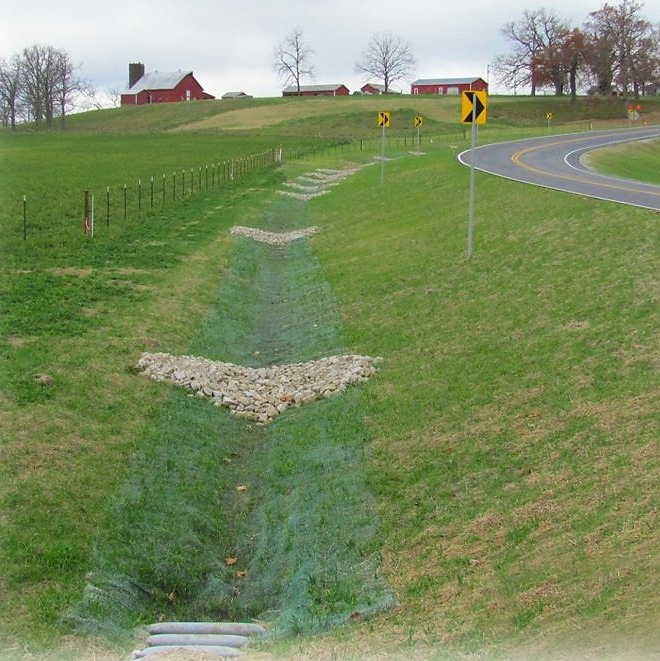Check Dams

Description
A check dam is a small dam constructed across a drainage ditch, swale, or channel to lower the velocity of flow. Reduced runoff velocity reduces erosion and gullying in the channel and allows sediments to settle out. A check dam may be built from stone, sandbags filled with pea gravel, or logs.
Applicability
Check dams can be used where temporary channels or permanent channels are not yet vegetated, channel lining is infeasible and velocity checks are required. This practice may be used as a temporary or emergency measure to limit erosion by reducing flow in small open channels. This practice should be used with drainage areas of 2 acres or less. Check dams may be used:
- To reduce flow in small temporary channels that are presently undergoing degradation,
- Where permanent stabilization is impractical due to the temporary nature of the problem,
- To reduce flow in small eroding channels where construction delays or weather conditions prevent timely installation of non-erosive liners.
Advantages
- Inexpensive and easy to install.
- Reduce velocity and may provide aeration of the water.
- Check dams prevent gully erosion from occurring before vegetation is established, and also cause a high proportion of the sediment load in runoff to settle out.
- In some cases, if carefully located and designed, these check dams can remain as permanent installations with very minor regrading, etc.
- They may be left as either spillways, in which case accumulated sediment would be graded and seeded, or as check dams to capture sediment coming off that site.
Disadvantages/Problems
- Because of their temporary nature, many of these measures are unsightly, and they should be removed or converted to permanent check dams before dwelling units are rented or sold.
- Removal may be a significant cost depending on the type of check dam installed.
- Check dams are only suitable for a limited drainage area.
- May kill grass linings in channels if the water level remains high after rainstorms or if there is significant sedimentation.
- Reduce the hydraulic capacity of the channel.
- May create turbulence which erodes the channel banks.
- Clogging by leaves in the fall may be a problem.
Planning Considerations
- Check dams are usually made of stone. The center must be lower than the edges.
- The dams should be spaced so that the toe of the upstream dam is at the same elevation as the top of the downstream dam.
- Ensure that overflow areas along the channel are resistant to erosion from out- of-bank flow caused by the check dams.
- Check dams can also be constructed of logs, or pea gravel-filled sandbags. Log check dams may be more economical from the standpoint of material costs, since logs can often be salvaged from clearing operations. However, log check dams require more time and hand labor to install. Stone for check dams must generally be purchased. This cost is offset somewhat by the ease of installation.
- If stone check dams are used in grass-lined channels which will be mowed, care should be taken to remove all the stone from the channel when the dam is removed. This should include any stone which has washed downstream.
- Since log check dams are embedded in the soil, their removal causes more soil disturbance than will removal of stone check dams. Extra care should be taken to stabilize the area when log dams are used in permanent ditches or swales.
Design & Construction Recommendations
- Check dams can be constructed of rock, sand bags filled with peagravel, or logs. Provide a sump immediately upstream.
- The maximum spacing between the dams should be such that the toe of the upstream dam is at the same elevation as the top of the downstream dam.
- The rock must be placed by hand or mechanical placement (do not dump rock to form dam) to achieve complete coverage of the ditch or swale and to ensure that the center of the dam is lower than the edges. The rock used must be large enough to stay in place given the expected design flow through the channel.
- Log check dams should be constructed of 4 to 6-inch diameter logs embedded into the soil at least 18 inches.
- In the case of grass-lined ditches and swales, check dams shall be removed when the grass has matured sufficiently to protect the ditch or swale unless the slope of the swale is greater than 4 percent. The area beneath the check dams shall be seeded and mulched immediately after dam removal.
Design & Construction Recommendations
- Stone displaced from face of dam: Stone size too small and/or face too steep.
- Erosion downstream from dam: Provide stone-lined apron.
- Erosion of abutments during high flow: Rock abutment height inadequate.
- Sediment loss through dam: Inadequate layer of aggregate on inside face or aggregate too coarse to restrict flow through dam.
Maintenance
- Inspect after each rainfall event.
- Remove sediment accumulations.
- Check structure and abutments for erosion, piping, or rock displacement. Repair immediately.
- Remove check dam after the contributing drainage area has been permanently stabilized. Smooth site to blend with surrounding area and stabilize according to vegetation plan.
References
Massachusetts Department of Environmental Protection, Office of Watershed Management, Nonpoint Source Program, Massachusetts Nonpoint Source Management Manual, Boston, Massachusetts, June,1993.
U.S. Environmental Protection Agency, Storm Water Management For Construction Activities, EPA-832-R-92-005, Washington, DC, September, 1992.
Washington State Department of Ecology, Stormwater Management Manual for the Puget Sound Basin, Olympia, WA, February, 1992